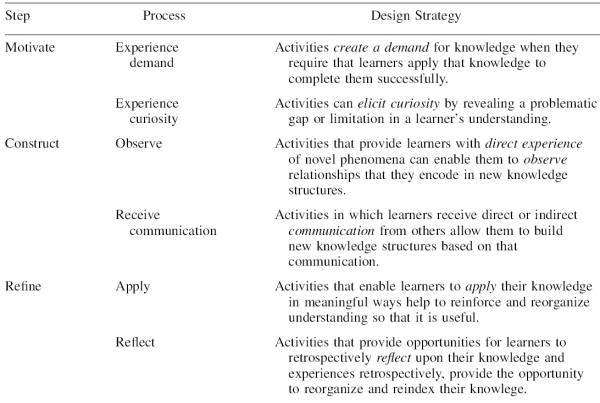To help me remember this issue for later, I’ve decided to explicitly post my responses to these questions in my blog. Those of you who are not interested in my personal responses to a reading for my ETEC 533 course can safely ignore this posting. 🙂
- Based on the reading, what broader educational challenges have provoked the author to do this research?
According to the author, teachers are "being asked to teach more content more effectively" and at the same time being required "[that] inquiry to play a much more prominent role in science learning". (Edelson 2000). This is an issue because both of these requirements of teaching take up more classroom time in a traditional classroom, and Edelson (2000) says that "[t]raditional science teachers often perceive these demands as unachievable." - What is the author’s theory of learning?
Based on this quote, "Learning takes place through the construction and modification of knowledge structures." (Edelson 2000), I suggest that this author is essentially a constructivist where the essential definition of constructivism I am using here is "learning is an active process of constructing rather than acquiring knowledge" as suggested by Duffy, T., Cunningham, D.J. (1996) - What are the pedagogical design principles that shaped the development of the WorldWatcher?
According to Edelson (2000), there are four design principle’s in the development of the WorldWatcher:- "…learning is the process of constructing new knowledge structures and forging new connections between knowledge structures in an interconnected web…"
- "…learning can be consciously monitored and directed through metacognitive processes…"
- "…knowledge is retrieved based on contextual cues…"
- "…an individual must have procedural knowledge that enables him to apply that declarative knowledge, or he must be able to transform it into procedural knowledge…"
The following table created by Edelson (2000) summarized the pedagogical considerations in the creation of the "Learning-for-use" model.

- Explain the reasons for integrating digital technology as a key part of this learning experience.
"WorldWatcher was designed to bring the power of scientists’ computational tools to learners" (Gordin & Pea, 1995).
- How are the pedagogical principles reflected in the design strategies suggested?
There are 6 phrases or words Edelson (2000) uses to describe the fundamental principles used: "Create demand, Elicit curiosity, Observe, Communication, Reflect, and Apply". Each of these words appears to lead to an activity used to satisfy this criteria in the WorldWatcher’s program. A major component of all of these criterion in the program is that computer related technology is used to make the implementation easier.
The second article we were told to read (Learning-for-Use in Earth Science: Kids as Climate Modelers) started off as largely a rehash of this article. This is probably due to the influence of Edelson as the author of the first article, and a co-author of the second. However, it then diverses to describe a piece of research by the authors. First they pretested some 8th grade students on their understanding of the relationship between Earth orbiting around the sun while rotating on its axis, and the seasons on Earth. Following this, they used some software called the "Planetary Forecaster" to help the students understand this relationship, and finally they post tested the students on their understanding. Not surprisingly, they discovered that most students understanding of the changing of the seasons had improved dramatically. A major flaw apparent to me in this research is a lack of a control group, wherein some students are taught using more tradional methods, and some students are taught using their software. This aside, the software seems very interesting and probably is responsible for a positive effect on the students’ understanding given what appear to be solid design principles.
What both articles have in common is that they are looking at the use of technology to assist in the understanding of geographic principles of Earth. Students are given training in the use of specialized technology, which is used as a tool in this instance, and guided toward an understanding. Although the authors claim to be used constructivist methods, it seems apparent that the lessons used are much too guided to allow for true constructivism on the part of the students. It seems clear to me that the students own prior knowledge is not being used to guide the learning process, and that the direction of the lessons are much too focused. I don’t mean to say that this is necessarily a bad thing, it is my experience that without sufficient guidance, students will wander aimlessly.
References:
Duffy, T., Cunningham, D.J. (1996). Handbook of research for educational communications and Technology. Association for Educational Communications and Technology.
Edelson, D.C. (2001). Learning-for-use: A framework for the design of technology-supported inquiry activities. Journal of Research in Science Teaching,38(3), 355-385.
Edelson, D., Salierno, C., Matese, G., Pitts, V., and Sherin B. (2002). Learning-for-Use in Earth Science: Kids as Climate Modelers. National Association for Research on Science Teaching, April, paper presented in New Orleans
Gordin, D.N., & Pea, R.D. (1995). Prospects for scientific visualization as an educational technology. Journal of the Learning Sciences, 4, 249-279.